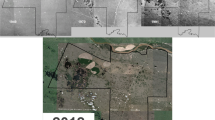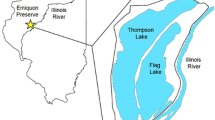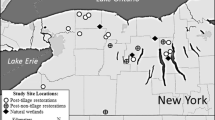Abstract
In 1805, the Lewis and Clark Expedition encountered Nez Perce people at a wet meadow that now holds historical significance to both cultures. Over the past two centuries this northern Idaho site, known as Weippe Prairie, was modified by digging of drainage ditches and introduction of exotic plants for livestock forage. From 2013 to 2017 a restoration was implemented that included filling a drainage ditch and planting five native wetland species. Between 2008 and 2018 we analyzed monitoring well data to quantify water levels through time, soil oxidation/reduction stations to measure redox potential, vegetation plots to track community changes, and pits for soil characterization. Seasonal saturation occurred top-down from direct precipitation and sheet flow over fine-grained soil and a low permeability hardpan approximately 60 cm below ground. Resulting hydrologic effects included a mean water level rise of 23 cm and prolonged growing season saturation. Although the restoration appears to be on a desirable trajectory, two years were insufficient for the wet meadow to transition from dominance by exotic pasture grasses to native wetland species. A combination of recurring monitoring, adaptive management, time, and reevaluation of the physical and ecological processes driving wetland function is required to achieve longterm restoration success.














Similar content being viewed by others
References
Batzer DP, Sharitz RR (2006) Ecology of freshwater and estuarine wetlands. Univ, Of California Press, Berkeley, 568p
Brady, N. C., and R. R. Weil. 2010. Elements of the nature and properties of soils. 3rd ed. Prentice Hall, Upper Saddle River, New Jersey
Clarke KR, Gorley RN (2015) PRIMER v7, 7th edn. PRIMER-E, Plymouth
Cooper DJ, Chimner R, Merritt D (2012) Western Mountain wetlands. Chapter 22, in: wetland habitats of North America: ecology and conservation concerns. Edited by: Darold P. Batzer and Andrew H. Baldwin, University of California Press, pp 313–328
Cooper DJ, Wagner JI (2013) Tropical storm driven hydrologic regimes support Spartina spartinae dominated prairies in Texas. Wetlands 33:1019–1024. https://doi.org/10.1007/s13157-013-0459-0
DeVoto B (ed) (1953) The journals of Lewis and Clark. Edited by Bernard DeVoto, Houghton Mifflin Company
Earle AS, Reveal JL (2003) Lewis and Clark’s green world: the expedition and its plants, First edn. Farcountry Press, Helena, MT
Galatowitsch SM, Anderson NO, Ascher PD (1999) Invasiveness in wetland plants in temperate North America. Wetlands 19(4):733–755
Galatowitsch SM, Whited DC, Lehtinen R, Husveth J, Schik K (2000) The vegetation of wet meadows in relation to their land-use. Environmental Monitoring and Assessment 60:121–144. https://doi.org/10.1023/A:1006159028274
Keddy, P.A., 2010. Wetland ecology: principles and conservation. Cambridge University Press
Klimkowska A, Dzierża P, Grootjans AP, Kotowski W, Van Diggelen R (2010) Prospects of fen restoration in relation to changing land use—an example from Central Poland. Landscape and Urban Planning 97:249–257. https://doi.org/10.1016/j.landurbplan.2010.06.009
Klimkowska A, Van Diggelen R, Bakker JP, Grootjans AP (2007) Wet meadow restoration in Western Europe: a quantitative assessment of the effectiveness of several techniques. Biological Conservation 140:318–328. https://doi.org/10.1016/j.biocon.2007.08.024
Klinka K, Scagel AM, Courtin PJ (1985) Vegetation relationships among some seral ecosystems in southwestern British Columbia. Canadian Journal of Forestry 15:561–569
Klotzli F, Grootjans AP (2001) Restoration of natural and semi-natural wetland Systems in Central Europe: Progress and predictability of developments. Restoration Ecology 9:209–219. https://doi.org/10.1046/j.1526-100x.2001.009002209.x
Kołos A, Banaszuk P (2013) Mowing as a tool for wet meadows restoration: effect of long-term management on species richness and composition of sedge-dominated wetland. Ecological Engineering 55:23–28. https://doi.org/10.1016/j.ecoleng.2013.02.008
Lackschewitz K (1991) Vascular plants of west-Central Montana--identification guidebook. Gen. Tech. Rep. INT-227. Ogden, UT: U.S. Department of Agriculture, Forest Service, Intermountain Research Station, p 612
Lewis RS, Burmester RF, Kauffman JD, Breckenridge RM, Schmidt KL, McFaddan MD, Myers PE (2007) Geologic map of the Kooskia 30 x 60 minute quadrangle. Idaho, Idaho Geological Survey, Moscow, Idaho
Maurer DA, Lindig-Cisneros R, Werner KJ, Kercher S, Miller R, Zedler JB (2003) The replacement of wetland vegetation by reed canarygrass (Phalaris arundinacea). Ecological Restoration 21(2):116–119
McDaniel PA, Falen AL (2014) Analysis of soils at the NPS Weippe prairie site: RM-CESU cooperative agreement number H1200090004 (natural resource technical report). Fort Collins, CO., National Park Service
McDaniel PA, Falen AL (2011) Analysis of soils at the NPS Weippe prairie site: final report under Rocky Mountain cooperative ecosystem studies unit cooperative agreement H1200040001 (natural resource technical report). Fort Collins, CO., National Park Service
McGrath CL, Woods AJ, Omernik JM, Bryce SA, Edmondson M, Nesser JA, Shelden J, Crawford RC, Comstock JA, Plocher MD (2002) Ecoregions of Idaho (color poster with map, descriptive text, summary tables, and photographs). US Geological Survey, Reston, VA 1(1350)
McMenamin SK, Hadly EA, Wright CK (2008) Climatic change and wetland desiccation cause amphibian decline in Yellowstone National Park. Proceedings of the National Academy of Sciences 105:16988–16993
Norton JB, Monaco TA, Norton U (2007) Mediterranean annual grasses in western North America: kids in a candy store. Plant and Soil 298(1–2):1–5
Patterson L, Cooper DJ (2007) The use of hydrologic and ecological indicators for the restoration of drainage ditches and water diversions in a mountain fen, Cascade Range, California. Wetlands 27:290–304
Schoeneberger PJ, Wysocki DA, Benham EC, Broderson WD (eds) (2002) Field book for describing and sampling soils, version 2. USDA-Natural Resources Conservation Service, Lincoln, Nebraska
Schook DM, Cooper DJ (2014) Climatic and hydrologic processes leading to wetland losses in Yellowstone National Park, USA. Journal of Hydrology 510:340–352. https://doi.org/10.1016/j.jhydrol.2013.12.038
Soil Survey Laboratory Staff. 2004. Soil survey laboratory methods manual. Soil survey investigations report no. 42, version 4.0. National Soil Survey Center, Lincoln, NE
Soil Survey Staff. 2008. Web soil survey: Clearwater area, Idaho (ID612). USDA-Natural Resources Conservation Service. Available at <http://www.websoilsurvey.nrcs.usda.gov>. Accessed 28 October 2010
Spyreas G, Wilm BW, Plocher AE, Ketzner DM, Matthews JW, Ellis JL, Heske EJ (2010) Biological consequences of invasion by reed canary grass (Phalaris arundinacea). Biological Invasions 12(5):1253–1267
Sueltenfuss J, Cooper DJ, Knight R, Wascom R (2013) The creation and maintenance of wetland ecosystems from irrigation canal and reservoir seepage in a semi-arid landscape. Wetlands 33:799–810
Tiner RW (1984) Wetlands of the United States: current status and recent trends. National Wetlands Inventory. U.S. Department of the Interior, Fish and Wildlife Service, Washington, D.C.
Vepraskas MJ (2001) Morphological features of seasonally reduced soils. In: Faulkner SP, Vepraskas MJ (eds) Wetland soils: genesis, hydrology, landscapes, and classification. Lewis Publishing, Boca Raton, Florida
Wienhold CE, van der Valk AG (1989) The impact of duration of drainage on the seed banks of northern prairie wetlands. Canadian Journal of Botany 67:1878–1884
Zeedyk, WD. 1996. Managing roads for wet meadow ecosystem recovery. U.S. Department of Agriculture, Forest Service. Southestern region. Report no. FHWA-FLP-96-016
Acknowledgements
This research and wetland restoration were supported by Nez Perce National Historical Park (NEPE) and the Water Resources Division of the National Park Service. We thank NEPE staff for their essential roles in making this project possible, including Jason Lyon, Heidi Tamm, Jannis LeBlanc, and Kathryn Matthews. We thank Anita Falen of the University of Idaho for her role in soil analyses, which also included helpful contributions from Mitch Valerio and Roger Falen. We thank the anonymous reviewer whose comments helped streamline and clarify the the manuscript.
Author information
Authors and Affiliations
Corresponding author
Additional information
Publisher’s Note
Springer Nature remains neutral with regard to jurisdictional claims in published maps and institutional affiliations.
Appendix
Appendix
Supplemental Figures
Rights and permissions
About this article
Cite this article
Schook, D.M., Borkenhagen, A.K., McDaniel, P.A. et al. Soils and Hydrologic Processes Drive Wet Meadow Formation and Approaches to Restoration, Western USA. Wetlands 40, 637–653 (2020). https://doi.org/10.1007/s13157-019-01200-8
Received:
Accepted:
Published:
Issue Date:
DOI: https://doi.org/10.1007/s13157-019-01200-8




